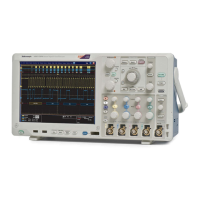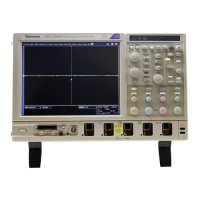Glossary
ASCII
Acronym for the A merican Standard Code for Information Interchange.
Controllers
transmit commands to the instrument using ASCII character encoding.
Address
A 7-bit code
that identifies an instrument on the communication bus. The
digitizing instrument must have a unique address for the controller to recognize
and transmit commands to it.
Backus-Naur Form (BNF)
A standard notation system for command syntax diagrams. The syntax diagrams
in this manual use BNF notation.
Controller
A computer or other device that sends commands to and accepts responses from
the digitizing instrument.
EOI
A mnemonic referring to the control line End or Identify o n the GPIB interface
bus. One of the two possible end-of-message terminators.
EOM
A generic acronym referring to the end-of-message terminator. The
end-
of-message terminator can be either an EOI o r the ASCII code for line feed
(LF).
Equ
ivalent-time sampling (ET)
A sampling mode in which the instrument acquires signals over many repetitions
of the event. This instrument uses a type of equivalent time sampling called
random equivalent time sampling. It utilizes an internal clock that runs
asynchronously with respect to the input signal and the signal trigger. The
instrument takes samples continuously, independent of the trigger position, and
d
isplays them based on the time difference between the sample and the trigger.
Although the samples are taken sequentially in time, they are random with respect
to the trigger.
Real-time sampling
A sampling m ode where the instrument samples fast enough to completely fill a
waveform record from a single trigger event. Use real-time sampling to capture
single-shot or transient events.
GPIB
An acronym for General Purpose Interface Bus, the common name for the
interface system de fined in IEEE Std-488.
IEEE
An acronym for the Institute for Electrical and Electronic Engineers.
DPO7000, DPO70000/B and DSA7000/B Series Programmer Manual Glossary-1

